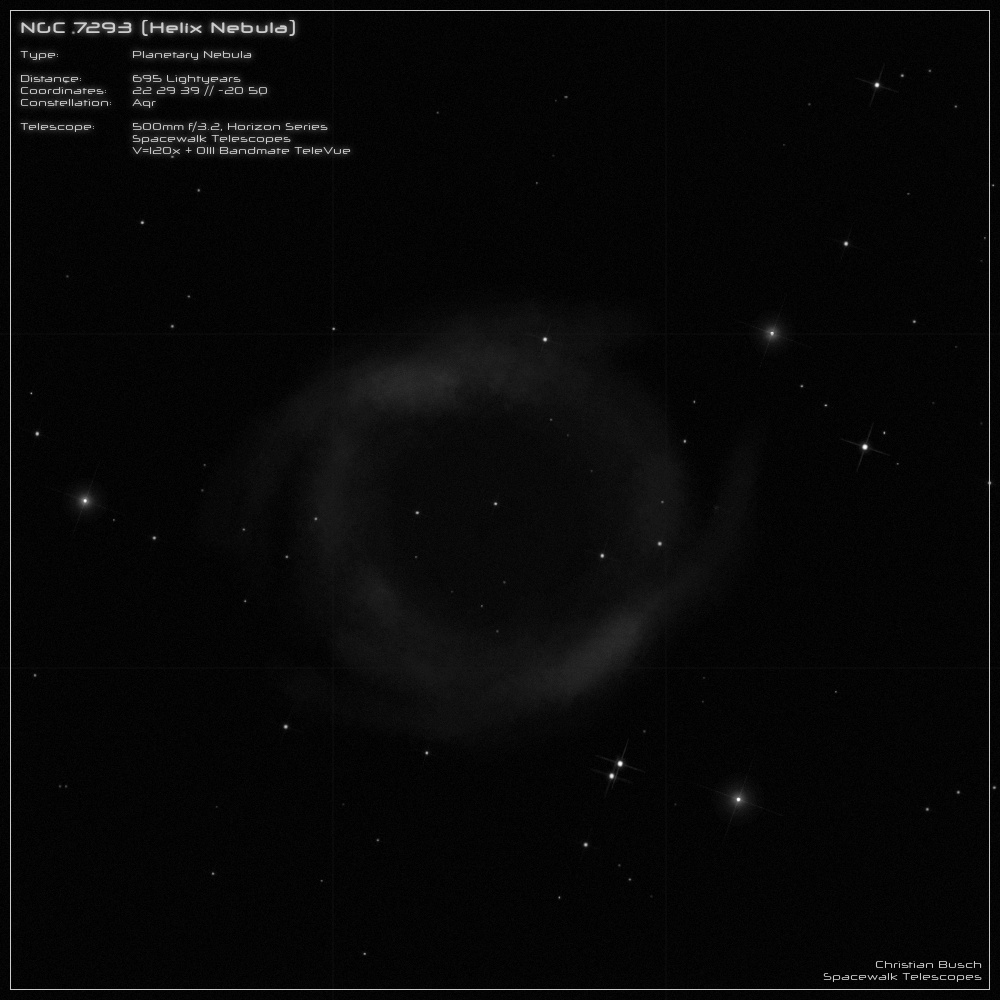NGC 7293 - Helix Nebula
The Helix Nebula is located in the constellation Aquarius. With the help of the satellite mission "GAIA" the distance could be determined to 655 light years,
which makes it the PN with the smallest distance to Earth. Due to its proximity to us, of course, its apparent size of 28'x16' is enormous - roughly the size of
the crescent moon in the sky. The apparent brightness is given as 6.3mag, but due to the very low surface brightness the nebula is anything but conspicuous.
The nebula itself is described as an ellipsoid and has a diameter of 2.5 light years. It was formed about 10,500 years ago and has been expanding into space
at about 30-40 kilometers per second ever since. So the nebula front would have crossed Germany within 20 seconds. Most of the material is located in the
equatorial plane of the nebula, which is inclined at an angle of about 30° in our direction. The Helix Nebula can be divided into 3 parts: an inner disk, the
torus, and the outer disk, which appears flattened on one side because it collides with the interstellar medium here.
On the images of the Hubble Space Telescope many comet-like formations can be recognized, so-called "Cometary Knots". A total of 40,000 of these knots
can be seen, each as large as our solar system. If you look closely at the knots, you can see a heated front (photoionization) in the direction of the central star,
as well as a tail on the far side, pointing away from the central star. Here material is driven outward by the stellar winds. The nodes in the center of the nebula
have a temperature of 1500°C, while the nodes at the edge of the helix nebula are only 600°C warm.
The central star (ZS) with 0.93 solar masses belongs to the massive representatives of its kind. Since white dwarfs become smaller the larger their mass is,
the ZS has a diameter of only about 11,000 kilometers and is thus even smaller than the Earth. The effective temperature is 117,000 Kelvin, so that an enormous
amount of radiation is emitted in the UV spectral band, which in turn leads to the photoionization and the "cometary knots" described above. The luminosity
of the white dwarf is 110 suns.
----------------------------------------------------------------------------------------------------------------------------------------------
Since the nebula lies at a declination of -20°, it never rises higher than 20° above the horizon in the south of Germany. Here, of course, the visibility is not as
good as at the zenith, so it is worth waiting for a really clear night on a higher mountain. Under such conditions the Helix nebula shows its best side and with
my 20" f/3.2 telescope many interesting structures can be seen.
The observation was made at a magnification of 120x in combination with an OIII filter. The ring itself appears quite bright and on closer inspection you can
see brighter spots and edges. The dark indentations on the left side of the nebula are only indicated, as well as the extensions and filaments outside the torus.
All in all, the structures are not easy to catch, which is mainly due to the low surface brightness.
Without filters the central star and many other stars can be seen in the nebula.

